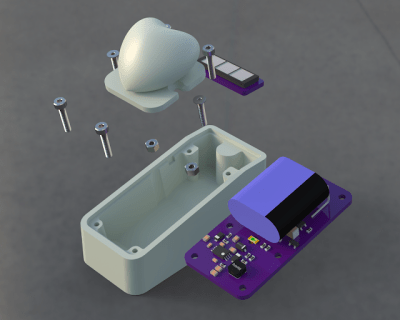It’s often said that if something is worth doing it’s worth doing right, or maybe even worth overdoing. This is clearly a concept that [ANTALIFE] takes very seriously, as made abundantly clear by projects like the solar powered “beating” heart he made as a gift for his wife. What for most of us would have ended up being a junk bin build becomes a considerable engineering project in his hands, with a level of research and fine tuning that’s frankly staggering.
 But [ANTALIFE] didn’t put this much thought into the device just for fun. He wants it to remain functional for as long as 30 years, and hopes he and the missus can still look on it fondly in their retirement years. Keeping an electronic device up and running for decades straight means you need to look carefully at each component and try to steer clear of any potential pitfalls.
But [ANTALIFE] didn’t put this much thought into the device just for fun. He wants it to remain functional for as long as 30 years, and hopes he and the missus can still look on it fondly in their retirement years. Keeping an electronic device up and running for decades straight means you need to look carefully at each component and try to steer clear of any potential pitfalls.
The biggest one was the battery. More specifically, the fact he couldn’t use one. The lifetime of most rechargeable batteries is measured in hundreds of cycles, which for a device which will be charged by solar every day, means the battery is going to start showing its age in only 4 to 5 years. That simply wasn’t going to cut it.
[ANTALIFE] did some digging and realized that the solution was to use a supercapacitor, specifically the AVX SCMS22C255PRBA0. This is little wonder is rated for a staggering half million cycles, which in theory means that even with daily use it should still take a charge in the year 3300. In practice of course there are a lot of variables which will reduce that lifetime such as temperature fluctuations and the Earth being conquered by apes; but no matter what caveats you put on the figure it should still make 30 years without breaking a sweat.
Similar thought was given to choosing a solar cell with a suitably long lifetime, and he did plenty of testing and experimentation with his charging circuit, including some very nice graphs showing efficiency over time, to make sure it was up to snuff. Finally he walks the reader though his light-sensitive ring oscillator circuit which gives the device its pleasing “breathing” effect once the lights go down.
We’d love to bring you an update on this device in 30 years to see how close [ANTALIFE] got, but as we’re still trying to work the kinks out of the mobile version of the site we can’t make any guarantees about what the direct-brain interface version of HaD might look like. In the meantime though, you can read up on the long term battle between supercapacitors and traditional batteries.
















“This is little wonder is rated for a staggering half million cycles, which in theory means that even with daily use it should still take a charge in the year 3300” That isn’t what that means at all…. that just means that it only degraded by the amounts specified when cycled that many times over as short a period as possible during testing.
There are *separate* measures that you should use for derating lifetime durability such as the rated hours and temp which will likely more accurately predict lifetime.
If you really wanted something to last 30 years… 10-15x GRM31CR60J227ME11L for similar price in parallel would probably be much more reliable and could be charged to a higher voltage, supercaps don’t like being charged to their full voltage it shortens their lifespan.
I think writer is correct here, the datasheet states by the time cycles tick over 500000 the capacitance would have dropped by at least 30%. But the capacitor will still be operating as a capacitor, just 30% worse than it was as start.
Totally right about supercapacitors being ran at rated voltage. The part I chose is rated for 5V and I run it at 4V to help with lifetime. AVX also released a couple of good white papers for this family of super capacitors though all their tests were done at 85°C, still these give a good idea about expected lifetime:
https://www.avx.com/docs/techinfo/whitepapers/AVX-Whitepaper-Reliability-of-SuperCapacitors-Paper1.pdf
https://www.avx.com/docs/techinfo/whitepapers/AVX-Whitepaper-Reliability-of-SuperCapacitors-Paper2.pdf
Also given that the supercapacitor is 2.5F (SCMS22C255PRBA0), I think you are looking at x12000ish of GRM31CR60J227ME11L. Sounds like a whole lot of board space to me ;^)
Your assumption about the batteries charge cycles is wrong. Its not just hundreds of any cycles, its full cycles.
If you discharge and charge by 10%, you will do this 10 times to reach 1 full cycle. At least with lithium batteries.
Thats why it doesn’t matter how often you plug your phone into the charger, despite some people still believing this. With Lithium batteries you could do that.
Dunno about that, the 10% DoD I state is taken directly from the datasheet.
DoD means Depth of Discharge, and a value of 10% means that the battery only has 10% of it’s original capacity left (as in 90% of the capacity has been used). By the looks of things 10% DoD seems to be an industry standard when testing Lithium based batteries.
Brotwurst oh you are totally correct. My bad I did not understand DoD correctly.
Like you said 10% DoD means you only discharged 10% of the capacity…